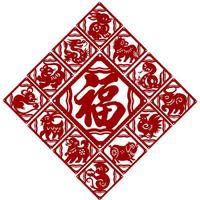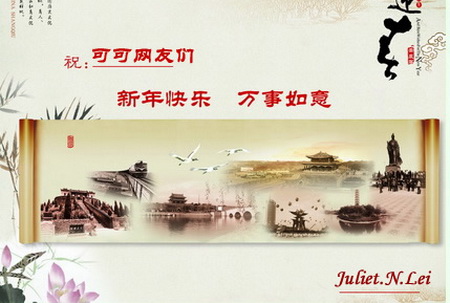各位親愛的朋友們,這里是話說地道美語春節特別節目,歡迎走近我們中國春節習俗文化的語聊室,我是Juliet。今天是農歷正月初五,在此,先給大家拜個年——祝您事業好、感情好、家庭好、身體好!在新的一年,我們的生活依然會有往年的酸甜苦辣,但是我想在那時那刻,有句情人或愛人濃濃的情話,您就會醉心。有句來自親朋好友暖暖的問候、深深的祝福,您就覺得貼心,感到溫馨。不管生活是福是禍,在自己的努力下,在親朋好友的扶持下,擁抱開心、奔向幸福、享受甜蜜!不要苦著自己,傷著自己。總之,Juliet在此誠摯地祝福您在2012年擁有健康青春的心態去工作、學習和生活,每天都有豐足的收獲。


說道親朋好友,我們在春節走訪親朋好友的時候,不僅會看到門上貼的春聯,還會看到有的人家窗戶上回貼有“窗花”。我們今天就來聊一下春節“貼窗花”的文化習俗。有這么一段中英文夾雜著的話,我們來看一下:
People in north of China 習慣于把剪紙貼在on their windows. It's also a kind of house decorations like couplets in the Spring Festival, which give an auspicious atmosphere. There are all kinds of 剪紙。However, 要提及的the most important one is a red character of "Fu". It means good luck and fortune. So, 在吉祥喜慶的場合,人們習慣把a red character of "Fu"貼在on doors or walls.
這段話老外聽起來可真是不清不楚的,那么如何讓老外清楚地明白我們的意思和了解我們春節貼窗花的習俗呢?那么,通過下面的學習,您稍事加工一下上文,他們就會明白了。
首先,我們來學幾個生詞。
1. Paper-cut剪紙
這是一個復合詞,這個詞源于動詞短語cut paper(裁紙)。它的構詞法是名詞paper和動詞cut通過連字符連接而成。
Eg. Chinese folk paper-cut art has a long history and a profound cultural meaning so it is regarded as a wonderful work in the folk realm of art. 中國民間剪紙藝術有著悠久的歷史淵源和豐富的文化內涵,是我國民間藝苑中的一朵奇葩。
2. Post
It means"to put a notice etc. In a public place so that people can see it." 中文意思是張貼,公布。
Eg. Advertisements have been posted up everywhere announcing the new show. 到處貼滿了廣告宣傳這一新節目。
注解:Announcing the new show是現在分詞短語做原因狀語。Show是名詞,是“節目”“演出”的意思。
Eg. The names of the members of the team will be posted up today. 隊員名單將于今天公布。
注解:post up是張貼的意思,就是相當于post,up可用可不用。
Eg. The result to the best performance awards will be posted on the Internet. 最佳表演獎的結果將在互聯網上公布。
注解:On the Internet是“在互聯網上”的意思。Internet的第一個字母要大寫,它要定冠詞the連用。The result to是一個名詞短語,表示“......的結果”。
3. customary ['kʌstəməri] 習慣的, 慣例的
這個詞由名詞custom 而來,它是它的形容詞,在custom這個名詞的后面加了a,r,y三個字母。Custom 既有“習俗”的意思也有“習慣”“慣例”的意思。
Eg. It's customary to give people gifts on their birthdays. 給人送生日禮物是常事。Is it customary to tip waiters in your country? 在貴國依照慣例是否應該付給服務員小費?
4. mention ['menʃən]
It means "to write or speak about sth/sb briefly" or " say the name of sth/sb" or " refer to sth/sb" . 中文意思是寫到、說到或提到某事物或某人。我們來看它的用法——
(1)..., not mention to... 且不說......
Eg. He has a big house and an expensive car, not to mention a villa in France. 他有一所大房子和一輛昂貴汽車,且不說在法國還有一座別墅了。
(2)mention sth/sb to sb 向某人提及某人或某物
Eg. He mentioned to John that he had seen you. 他(跟約翰)說他見過你。
(3)mention doing sth 提到做某事;說道做某事
Eg. Whenever I mention playing football, he says he's too busy. 我一跟他提踢足球的事, 他就說太忙。
(4)mention...as... 提起......就像......
Eg. They mentioned you as a good source of information. 他們說你消息靈通。
(5)口語句子:Did I hear my name mentioned? (ie Was somebody talking about me?)有人提起過我嗎?
(to be continued)
若您對本堂課有任何疑問,不妨加入可可口語交流QQ交流群共同討論,群號為134126489 ,或者您以郵件形式將你的疑問發送到我的信箱,Juliet的信箱:leinadancingroom@qq.com












